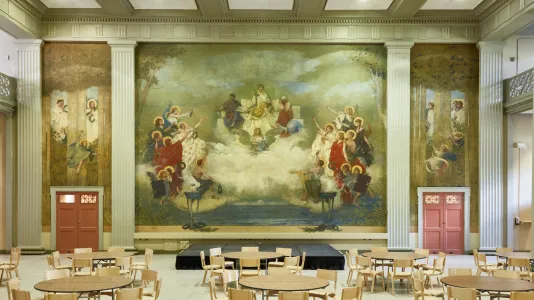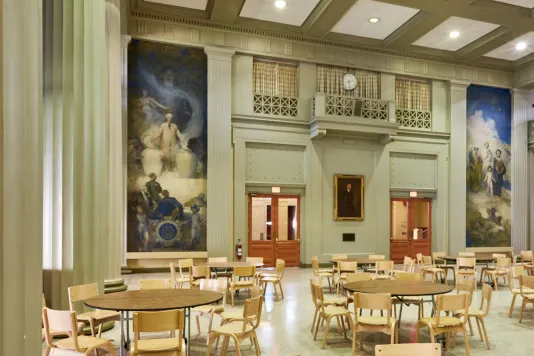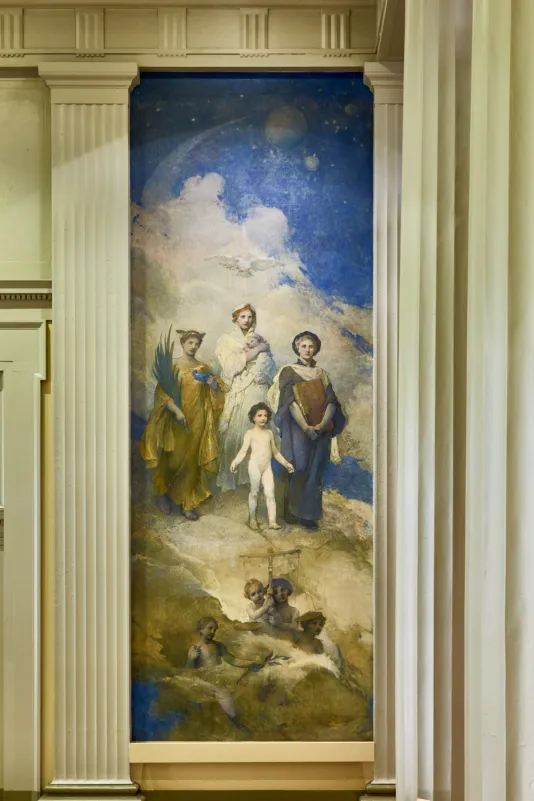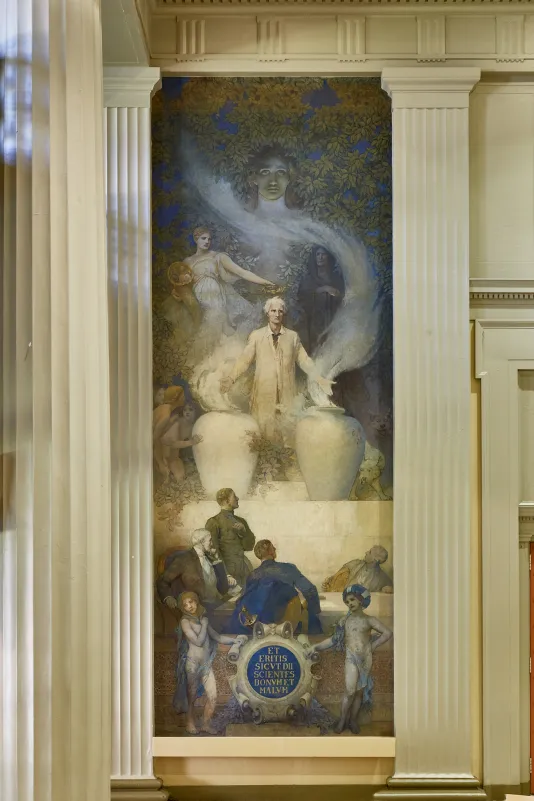Edwin Blashfield, Walker Memorial Mural, 1923–30. Photo: Charles Mayer Photography
Walker Memorial Mural, 1923-30

Commissioned by the industrialist and MIT treasurer Everett Morss, these imposing mural paintings, painted on huge pieces of canvas adhered to the wall, were the first permanently installed works of art on the MIT campus. They were painted by Edwin Howland Blashfield, one of the most celebrated artists and muralists of his day, who began his studies at MIT with the class of 1869, and had intended to become an engineer before studying painting with Léon Bonnat in Paris.
The central panel on the north wall, an homage to Alma Mater, is rigidly symmetrical. Alma Mater, clothed in white robes and seated on a throne lofted in the clouds, is flanked by two groups of haloed acolytes extending laurel wreaths. Hailed by personifications of learning and of the various branches of knowledge, Blashfield’s Alma Mater appears to draw on the iconography of Romanesque “Seat of Wisdom” Virgin Mary as well as the Roman “Magna Mater” Cybele. The figures depicted hover above the Charles River Basin and the MIT buildings appear suspended in the background. This panel was painted in less than three weeks in late 1923, when the artist was almost 80 years old. (He was assisted by Vincent Aderente, whose signature can be seen with Blashfield’s.)
The two side panels, completed in 1924, bring the elevated scene down to earth by depicting a grove of trees through which unexplained spectral figures glide. The murals on the south wall were not executed until 1930. The right panel, Humanity Led by Knowledge and Invention, depicts a mother and children of varying ages progressing from chaos to light, accompanied by cherubs bearing the scales of justice. On the left, the darkest and most dramatic mural represents the ethical challenges of science: a lab-coated scientist, crowned by a figure said to be Hygieia (the Greek goddess of health), stands between two giant jars containing beneficent and malevolent gasses, symbolizing the constructive and destructive possibilities with every new discovery. A Latin inscription from Genesis reads, “Ye Shall Be As Gods Knowing Good and Evil.” The horrors of World War I were still fresh at the time of the mural’s creation; Blashfield depicts dogs of war lurking near the evil gasses and famine threatening in the background. A strangely disproportionate dark head within the shadow of the Tree of Knowledge is said to represent nature; her relation to the rest of the drama is (perhaps deliberately) unclear.
Edwin Howland Blashfield (1848–1936) was influenced in his monumental and allegorical painting style by Pierre Puvis de Chavannes, Jean-Paul Laurens, and Paul Baudry, whose decorations he had studied in the Paris Panthéon. In 1887, he traveled to England and became briefly associated with the Anglo-American artist colony in the village of Broadway, which included John Singer Sargent, Henry James, and Frederic Leighton. After returning to the US and setting up a studio in New York, Blashfield displayed his murals at the 1893 World’s Columbian Exhibition in Chicago. His best-known works are the dome of the Library of Congress Reading Room in Washington, D.C.; the capitol buildings of Iowa, Minnesota, South Dakota, and Wisconsin; and various other churches and public institutions throughout the United States.


